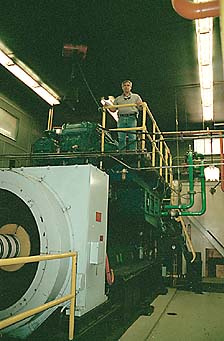
June 25, 2001
UCSC buys cogeneration plants; will provide electricity to campus core during blackouts
By Louise Donahue
As talk of rolling blackouts this summer continues, UCSC has bought itself some breathing room in the form of a backup energy source.
 |
| The cogeneration engine is in the process of being readied for use as an emergency power source. Standing over the engine is Jim West, building and utility services senior superintendent. Photo: Louise Donahue |
Earlier this month, UCSC paid $250,000 to buy the cogeneration plants that the privately owned Santa Cruz Cogeneration Associates had owned and operated on campus from 1985 until December 2000.
UCSC expects the two plants to be ready for use in about a month.
"The purchase of these plants gives us security," said Jim West, building and utility services senior superintendent.
"It is important that the campus community continue to conserve to avoid rolling blackouts in the region. However, should the campus be hit with an outage, the plants, once upgraded, will at least provide electricity to a portion of the campus," said Ilse Kolbus, acting director of the Physical Plant.
The plants are described as "cogeneration" because they produce both electricity and heat. Cogeneration Associates was forced out of business when it could not pass along its soaring costs for natural gas, which fuels the plants.
Campus peak demand for electricity is 7 megawatts, while the cogeneration plants together produce 2.89 megawatts. The main plant, located off McLaughlin Drive near the Communications Building, produces 2.6 megawatts (2,600 kilowatts), and a smaller plant at the East Field House provides 290 kilowatts. In an emergency, the plants would power Baskin Engineering Building, Communications, the Fire Station, Cowell Health Center, Sinsheimer Labs, Thimann Labs, Natural Sciences 2, the Science Library, and the East Field House.
"It's a pretty good deal," said Kolbus. The asking price for the plants had been $500,000, she said, adding that the eventual purchase price stacked up well against the alternatives of adding multiple generators or building a new generating facility.
Kolbus said it usually costs roughly $1 million to create one megawatt of power. The cost of adding needed generators would also have been about $2.5 million, she said, and there would have been additional complications because of the pollution generated and the need to get permits, add new wiring, and find places to put the bulky machines. "It was fortunate that the plants were here," Kolbus said of the cogenerating facilities.
The original construction of the main cogeneration power plant--putting the engine and high-voltage switch gear in place--cost $3.5 million, said West, echoing Kolbus' view that the university got a good price. The plant was added to UCSC's Central Heating Plant in 1985, under an agreement in which UCSC purchased the electricity and heat it produced and the company earned a profit. The East Field plant was added two years later.
Blackout-caused power outages have been a major concern for researchers and staff who use UCSC's science facilities, according to West. Researchers said they could go without power for only a couple of hours without risking harm to some research projects.
Once the cogeneration plants are ready for backup duty, power will switch over in 15 or 20 minutes during a power outage, West said. Work is now under way to get the main cogeneration engine converted to keep it warmed up, for quick start-up and electrical loading. This conversion process is likely to take about 30 days.
If the plants--and UCSC's utility crew--are pressed into emergency duty, it won't be the first time. The main cogeneration plant's ability to operate on either natural gas or diesel oil turned out to be especially valuable in the aftermath of the Loma Prieta earthquake, recalled West, who was on staff at the time.
When the earthquake struck, the cogeneration engine went down, too, as designed. The engine was then checked and started up again using diesel, and provided electricity and heat for three days until regular power was restored. The East Field plant operated during the emergency using natural gas. "We're
experienced with emergency situations," West said.
In the short term, UCSC is seeing the cogeneration plant as simply a backup facility. "What we like to call ourselves is a standby power plant," said West. Later, if the energy market changes and it becomes cost-effective to run the plant all the time, UCSC could potentially sell back any extra capacity to the state's power grid.